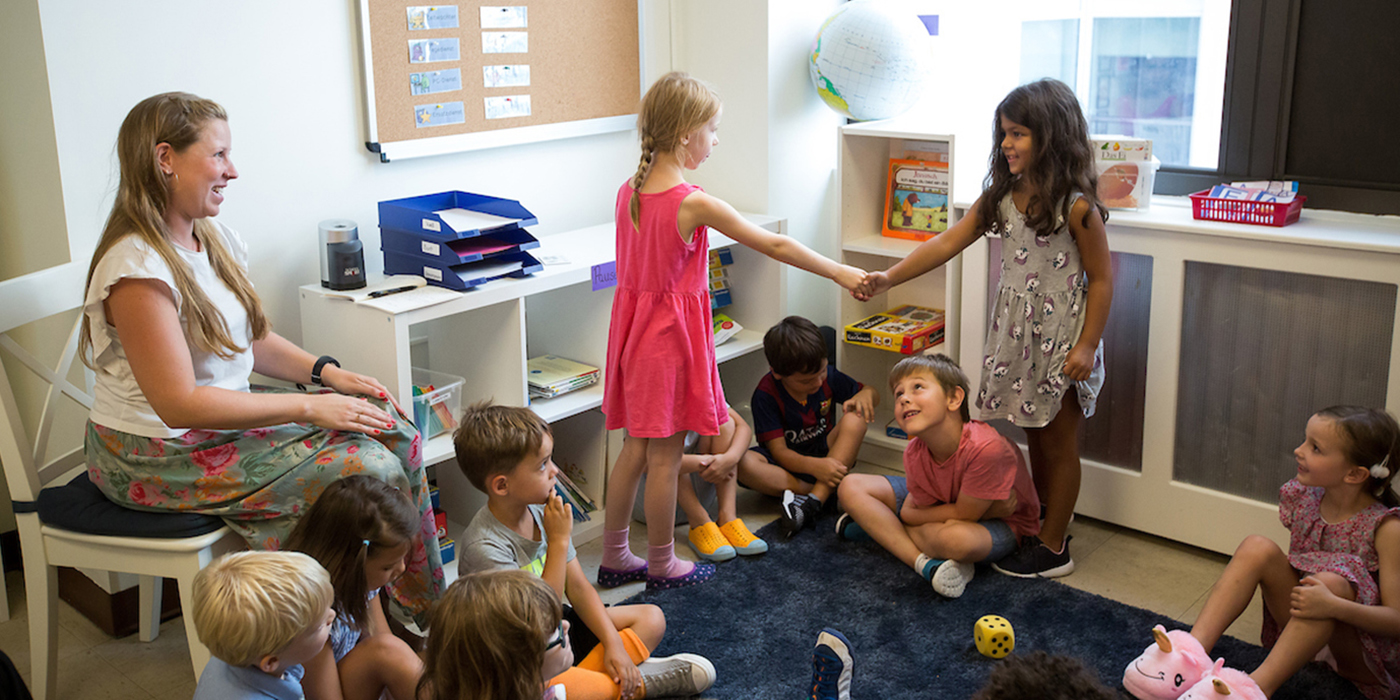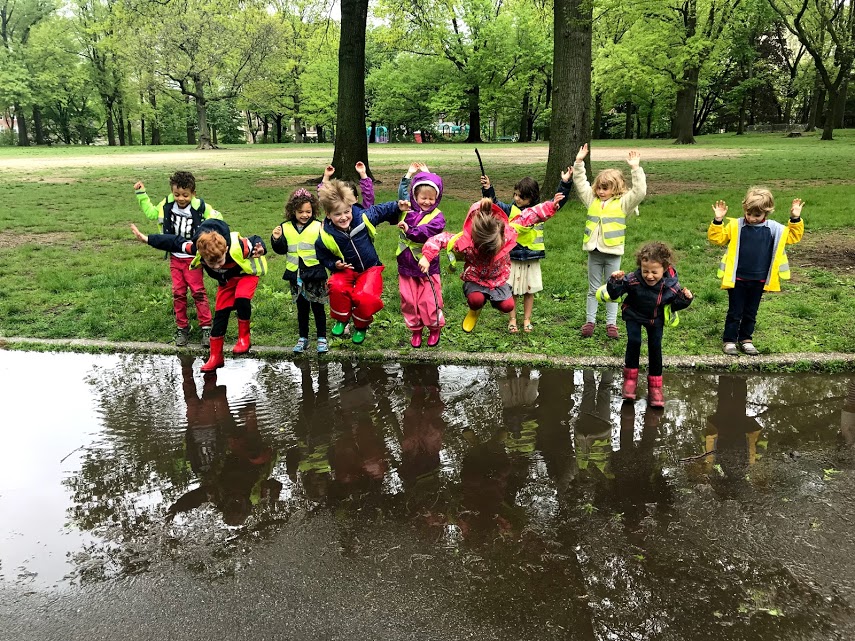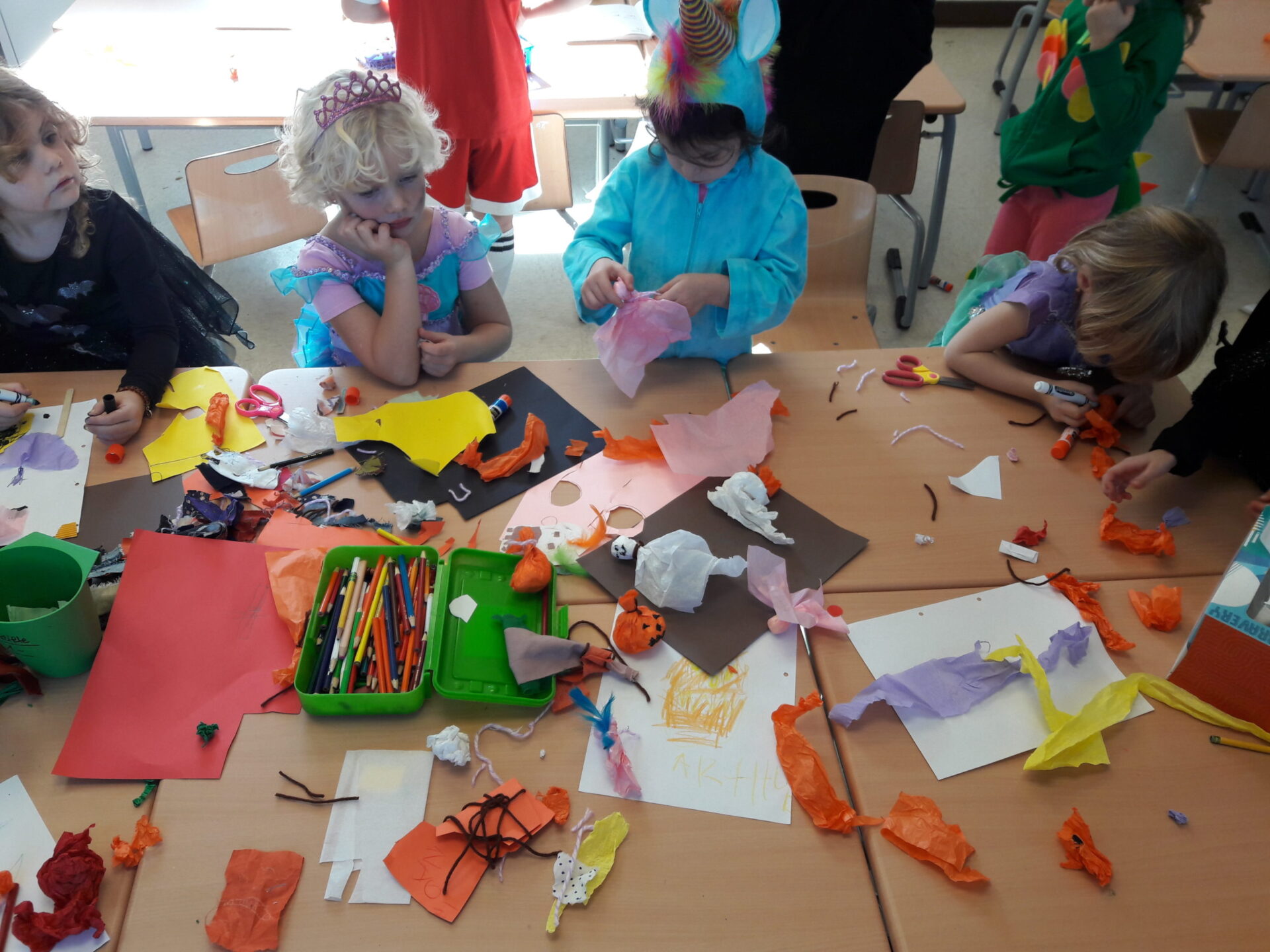Lower School
General Information
We focus on development of the whole child by nurturing the social-emotional, academic, and artistic interests of our learners.
The Lower School years are a precious time. Our young learners develop skills, acquire knowledge, and develop strategies for growing academically, creatively, and socially. Students build a strong academic foundation while pursuing their individual interests as they become lifelong learners.
German School Brooklyn’s Lower School academics are based on two curricula: the German Curriculum from Thüringen and a Common Core-aligned curriculum. This bilingual approach prioritizes full language immersion during the time when children are developmentally able to become entirely fluent in both English and German.
Students have ample opportunity to explore a range of subjects, interests, and creative pursuits. We take a whole-child approach, ensuring that each child is engaged, supported, and challenged, starting in their youngest years at GSB.
Caring, skillful teachers and inquiry- and project-based teaching strategies aim to make class time dynamic and student led. We strive to spark our students’ inherent curiosity about the world. We give them the tools to learn by developing their abilities to think analytically and creatively, all the while finding ways to make learning joyful and fun.
We believe in the importance of play. Socialization, problem-solving, physical activity—the list could go on. Students have time to play each day and can use their break time to explore varied activities. Students also go outside for recess each day.
Through it all, we pay close attention to our students’ social-emotional growth. Our young students are starting to discover who they are, what they are interested in, and how they’d like to express themselves. We expose them to ways of living in the world and support their identity development throughout these formative years. We help our students acquire the ability to communicate well with their friends, their teachers, and other people in their lives, and we help them grow into responsible, intelligent, caring citizens of the world.
Curriculum Overview
LANGUAGES
German Language
Our German curriculum is based on the most modern German curriculum of Thuringia and includes reading, creative writing, spelling, grammar, and oral expression.
We motivate students to become independent readers from the beginning, through read-alouds and action-oriented, hands-on engagement with stories and non-fiction texts. At the same time, we enable students to develop a secure knowledge of letters, of letter sounds, and of combining sounds to make words, so they will acquire both the technical skills to decode the content of texts and the joy of reading. Through writing their own texts, students develop their own theories of the rules of written language. We build on these theories by introducing spelling and grammar rules and by expanding vocabulary. In the area of oral expression, we create a variety of opportunities for conversation and teach students to narrate, discuss, argue, and present.
English Language
Our Lower School reading program encourages students to become flexible, resilient readers. Students are exposed to a variety of genres, including picture books, news articles, non-fiction books, short stories, novels, plays, and poetry. Discussions and close readings of selected passages enhance vocabulary development, comprehension skills, and development of opinions and conclusions based on evidence in texts. Explicit phonics instruction, especially in Grades K–3, is also an important building block for our young readers.
Our program focuses on opinion, argument, informational and narrative writing, which develop students’ ability to write both academically and creatively. Within our writing units, students experience the entire writing process: pre-writing, drafting, revising, editing, and publishing. Through this practice, students develop knowledge of grammar, sentence structure, writer’s voice, audience, and overall organization.
Our classroom libraries allow students to choose books that they want to read at the appropriate level for them. Lessons include individual, partner, small-group, and whole-class instruction.
Spanish (English)
Our Spanish program takes a conversational approach in Lower School. Students are exposed to the language through storytelling, songs, brief video selections, poems, and games. They study places around the world, including cultures that speak Spanish. Vocabulary and grammar expectations grow each year, and students practice not only conversing but also presenting projects in Spanish.
HUMANITIES
Social Studies (English)
Our social-studies curriculum, tailored to the interests of our young learners, includes history, geography, economics, government, and civics. Really, it’s the study of humanity—the people and events that collectively have shaped our nation and our world. Topics include family, identity, community, occupations, and geography, along with elements of United States and New York State history, including the study of Native peoples and colonization.
We strive to help students make sense of the world, encouraging them to make connections between major ideas and their own lives, and helping them see themselves as active members of a global community. In addition to teaching content, we engage our students in historical thinking: raising questions, thinking critically, considering varied perspectives, and gathering evidence in support of interpretations.
MATHEMATICS AND SCIENCES
Math (German and English)
Our Lower School curriculum follows an integrated approach to mathematics, with a deeper focus on understanding mathematical concepts. It is based on the most modern German curriculum from Thuringia. The curriculum sets the foundation for the Upper School’s IB program, even in a student’s youngest years.
Our curriculum specifies four subject areas based on geometry, arithmetic, and quantities. Factual arithmetic plays a role in all of them.
-
Shape and change (developing spatial awareness, orientation in space and plane).
-
Numbers and operations (developing ideas about numbers and operations, ordering numbers, and operating with them).
-
Sizes and measurement (understanding the idea of measurement, developing ideas about quantities).
-
Data and chance (collecting, evaluating, and critically reflecting on data, developing a sense of probability).
General math skills we teach include problem-solving, communicating, reasoning, modeling, and representing. Students learn, among other concepts, how to:
- Describe mathematical facts using technical language.
- Recognize, justify, and describe mathematical relationships.
-
Extract and communicate relevant information from texts and visual representations.
- Represent, comment on, reflect on, and evaluate solution processes.
Science (English)
Our science instruction seeks to lead students through investigation, so they ask questions and devise experiments to make sense of the world around them. Integrating literacy skills like reading and writing and numerical abilities like math (data collection and engineering), our science instruction is interdisciplinary while fostering critical and analytic thinking about each topic.
Throughout the year, students collaborate with one another, identify problems, and create possible solutions through hands-on study. These concrete experiences lead students into new ways of thinking and deepen their understanding of science concepts.
Each grade level works through the three branches of science—physical, earth, and life sciences—with thematic units. In each unit, teachers approach the branch with projects and investigations to create meaningful experiences.
THE ARTS AND MOVEMENT
Visual Art (German)
Our Lower School art program encourages students to be imaginative while learning actual making skills. Students are challenged to develop endurance in the making process, to become critical thinkers, to appreciate various forms of art, and to understand art as a process of exploration and discovery. Our young artists explore skills, concepts, motivation, and intuition in art-making in various mediums, such as print-making, drawing, painting, sculpture, collage, and applied design. Through each, students learn how to express their ideas and to use principles of visual art. At the same time, students develop essential habits of mind that influence their classroom learning. Through child-centered teaching, students expand their creativity, self-confidence, and self-expression.
Music (German)
The music curriculum exposes students to compositions from various cultures, languages, and styles. Students listen to and analyze music from different genres and learn about instruments along with musical elements, such as dynamics, form, and tempo. Students acquire a range of vocal skills, including solfege, posture, and breathing. They also perform, read, and write their own rhythms and melodies, and they play a variety of instruments over the years. We also integrate opportunity for students to compose and improvise and to explore their own approach to music-making.
Dance and Yoga (English)
The Lower School dance program focuses on building students’ knowledge of creative dance concepts (Grades 2 and 3), jazz technique (Grade 4) and hip-hop (Grade 5). There is an emphasis on guided improvisation, collaboration, and problem-solving through choreographing for performance. Students perform in September and June, during GSB’s Project Week performances, in which the academic curriculum is tied into the dance-making process. Yoga is woven into the course of study with a focus on meditation, asanas (postures), and inversions.
Physical Education (English)
Our physical-education curriculum highlights body awareness, coordination, and teamwork. Students are introduced to movement patterns and techniques in our running, yoga, gymnastics, and fitness units.
Team-building and hand-eye coordination get a boost during our soccer and sport-games units. Games such as team handball and brennball (a bat-and-ball game) develop students’ game comprehension and strategy. Our main ingredients are having fun and giving one’s best effort.
Physical education is taught indoors and outdoors, depending on the season and weather.
Field Trips and Community Walks
The Lower School curriculum includes field trips and community walks that use our dynamic neighborhood and city as a classroom, to build community and encourage exploration of new places and ideas.
Throughout the school year, each grade goes on at least four field trips, which could include:
- Brooklyn Museum
- Brooklyn Botanic Garden
- New York Aquarium
- National Museum of Mathematics
- National Geographic Encounter
- Statue of Liberty/Liberty Island
- A visit to a farm
- Other teacher- and class-selected trips
School Events
School events are a joyful way to build community and foster students’ diverse interests. These include:
- Winter Project Week and performance
- Spring Project Week and performance
- Summer art exhibition and dance performance
- Author visits
- Kidpreneur Fair
- Book buddy days with classes in other grades
- Annual Kindness Initiative
- Reading/Pajama Day
-
Kindergarten
keyboard_arrow_downChildren enter their first year of school with a range of skill sets, developmental needs, and prior knowledge. The Kindergarten curriculum at GSB allows students to grow at their own pace and offers engaging, challenging learning experiences that support their social-emotional needs.
Approach to Academics
The major subjects in Kindergarten are German, English, and math. Within their German and English lessons, students learn to play with the components of language that support their literacy development. This pursuit includes activities that teach rhyming, syllabification, letter names, letter sounds, and blending sounds as students begin reading and writing words. In both languages, students engage in read-alouds, which allow them to explore genres of literature, including fiction, non-fiction, fairy tales, and poetry. Math class, offered in German, offers students hands-on activities that support their comprehension of numbers and quantities and offers them insight into addition, subtraction, shapes, patterns, and measurement.
Projects, Movement, and Play
In the afternoon, Kindergarten students engage in project-based learning, which integrates social studies, science, ethics, art, and music. During this project hour, students explore topics in depth, developing inquiry, exploration, and creative skills. Kindergarten students also have one hour of physical education a week, in addition to their daily park time.
Social-emotional Development
Alongside executing the academic program, Kindergarten teachers at GSB emphasize social-emotional growth through play. In their ample daily play time, students develop social skills, such as being a part of a group, building friendships, standing up for their rights and needs, and identifying their own feelings as well as identifying the rights, needs, and feelings of others.


